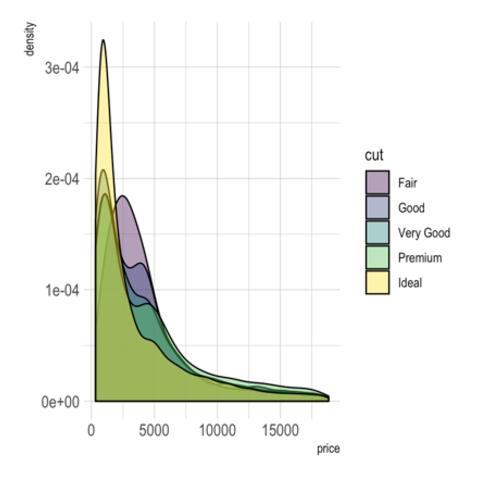If you've ever been fooled by the old question, 'Which weighs more: a pound of feathers or a pound of lead?' then you wouldn't be alone. Although the feathers and the lead both weigh exactly the same (um, a pound), their density is wildly different, and we can sometimes mentally conflate weight and density - even though they're different concepts. So - hey - don't feel dense. Read on to find out exactly what density is, how it works, and how to calculate density.
A measure of the quantity of some physical property (usually mass) per unit length, area, or volume (usually volume).♦ Mass density is a measure of the mass of a substance per unit volume. Put another way, density is the ratio between mass and volume or mass per unit volume. It is a measure of how much 'stuff' an object has in a unit volume (cubic meter or cubic centimeter). Density is essentially a measurement of how tightly matter is crammed together.
Density Equation
What is density?
Density is the mass per volume - not just the straight-up mass. So if the question was, 'Which weighs more: a 500ml jug full of feathers or a 500ml jug full of lead?' then the answer would be the lead. For an equal amount of space it takes up (volume), lead weighs much more than the feathers (mass).
Density can also be thought of as how compacted or compressed a substance is. A pound of feathers is filled with airy space, so it's not very dense at all, while a pound of lead feels much more solid, so it's more dense. This is why you should never comment on your Auntie Mabel's sponge cake by describing it as dense: she was probably going for something a little more airy.
Density is also what makes things float or sink. When you mix two or more substances, the most dense substance sinks to the bottom, whilst the least dense substance is more buoyant and floats to the top. Try mixing oil and water and see how they separate into layers, with the less dense oil on top.
How do you calculate density?
Always keep an eye on your units: it's standard to use g or kg per cm³ or m³, so use our unit converters if your measurements are in different units.
To calculate density, you divide the mass by the volume:
Density Meaning
Density = Mass ÷ Volume
Density is often written in mathematics as the symbol p or D. Mass can be written as m, and volume can be written as V. So if you want to be fancy, the formula looks like this:
p = m/V

(Volume is to do with filling space: check out our guide to volume and weight and our volume calculator if you're not yet confident with it.)
So, if you have a kilogram of cheese with the volume of 0.0002m³, then not only are you in for some weird and wonderful dreams, but you also have cheese with a density of 5000kg/m³ (p = 1kg ÷ 0.0002m³).
Try our density calculator to make it all a piece of cake. Hopefully even better than Auntie Mabel's lemon sponge..
What are the three formulas for density?
The formula we showed you above (p = m/V) is the one we use to calculate density, but as there are three elements to that formula, it can be expressed in three different ways. Basically, you can rearrange the structure to work out different elements.
- To work out density: p = m / V
- To work out the mass: m = p x V
- To work out the volume: V = m / p
For assistance with converting between units of mass and volume, give our weight and volume converter a try.
Some examples
Why not fill up your bath and try out some different materials to see what floats or sinks? Just no electricals, please. ⚡
Water has a density of 1000kg/m³, therefore anything that floats in water has less density than that, and anything that sinks has a greater density (for example, cooking oil is around 920kg/m³; tin is 7310kg/m³; cork is 240kg/m³; and Aerogel, one of the least dense solids we know of, has a density of 1kg/m³). So how come people float so easily in the Dead Sea? Because it's not just water. It has an incredibly high amount of salt in it, creating an overall density of 1240kg/m³.
CloudPw allows you to maintain a set of id/passwords along with optional attributes. Use a private DB on iCloud for backup purposes and to allow sync with corresponding app on IOS. Cloudpw. Cloud1.pw is a web-page which cons you and other unsuspecting victims into registering for its push notifications that go directly to the desktop or the internet browser. It claims that clicking ‘Allow’ is necessary to download a file, access the content of the webpage, and so on. CloudPw 3.2 for Mac can be downloaded from our website for free. The application lies within Security Tools, more precisely Personal Security. This free software for Mac OS X is a product of Bjorn Sellgren. CloudPW offers industry leading Peplink multi-WAN VPN bonding (SD-WAN) routers and access points.
Rate this article
Please rate this article below. If you have any feedback on it, please contact me.
Your comments
Please enable JavaScript to view the comments powered by Disqus.Please provide any two values to the fields below to calculate the third value in the density equation of

| ρ = | m |
| V |
The density of a material, typically denoted using the Greek symbol ρ, is defined as its mass per unit volume.
| ρ = |
| where: ρ is the density m is the mass V is the volume |
| mass |
| volume |
 . Note that density is also affected by pressure and temperature. In the case of solids and liquids, change in density is typically low. However, when regarding gases, density is largely affected by temperature and pressure. An increase in pressure decreases volume, and always increases density. Increases in temperature tend to decrease density since volume will generally increase. There are exceptions however, such as water's density increasing between 0°C and 4°C.
. Note that density is also affected by pressure and temperature. In the case of solids and liquids, change in density is typically low. However, when regarding gases, density is largely affected by temperature and pressure. An increase in pressure decreases volume, and always increases density. Increases in temperature tend to decrease density since volume will generally increase. There are exceptions however, such as water's density increasing between 0°C and 4°C.
Below is a table of units in which density is commonly expressed, as well as the densities of some common materials.
Common Density Units
| Unit | kg/m3 |
| kilogram/cubic meter | SI Unit |
| kilogram/cubic centimeter | 1,000,000 |
| gram/cubic meter [g/m3] | 0.001 |
| gram/cubic centimeter | 1000 |
| kilogram/liter [kg/L] | 1000 |
| gram/liter [g/L] | 1 |
| pound/cubic inch [lb/in3] | 27,680 |
| pound/cubic foot [lb/ft3] | 16.02 |
| pound/cubic yard [lb/yd3] | 0.5933 |
| pound/gallon (US) | 119.83 |
| pound/gallon (UK) | 99.78 |
| ounce/cubic inch [oz/in3] | 1,730 |
| ounce/cubic foot [oz/ft3] | 1.001 |
| ounce/gallon (US) | 7.489 |
| ounce/gallon (UK) | 6.236 |
| ton (short)/cubic yard | 1,186.6 |
| ton (long)/cubic yard | 1,328.9 |
| psi/1000 feet | 2.3067 |
Density of Common Materials

| Material | Density in kg/m3 |
| Earth's atmosphere at sea level | 1.2 |
| Water at standard temperature and pressure | 1,000 |
| The Earth | 5,515.3 |
| Iron | 7,874 |
| Copper | 8,950 |
| Tungsten | 19,250 |
| Gold | 19,300 |
| Platinum | 21,450 |
| Atomic nuclei | 2.3×1017 |
| Black hole | above 1×1018 |
